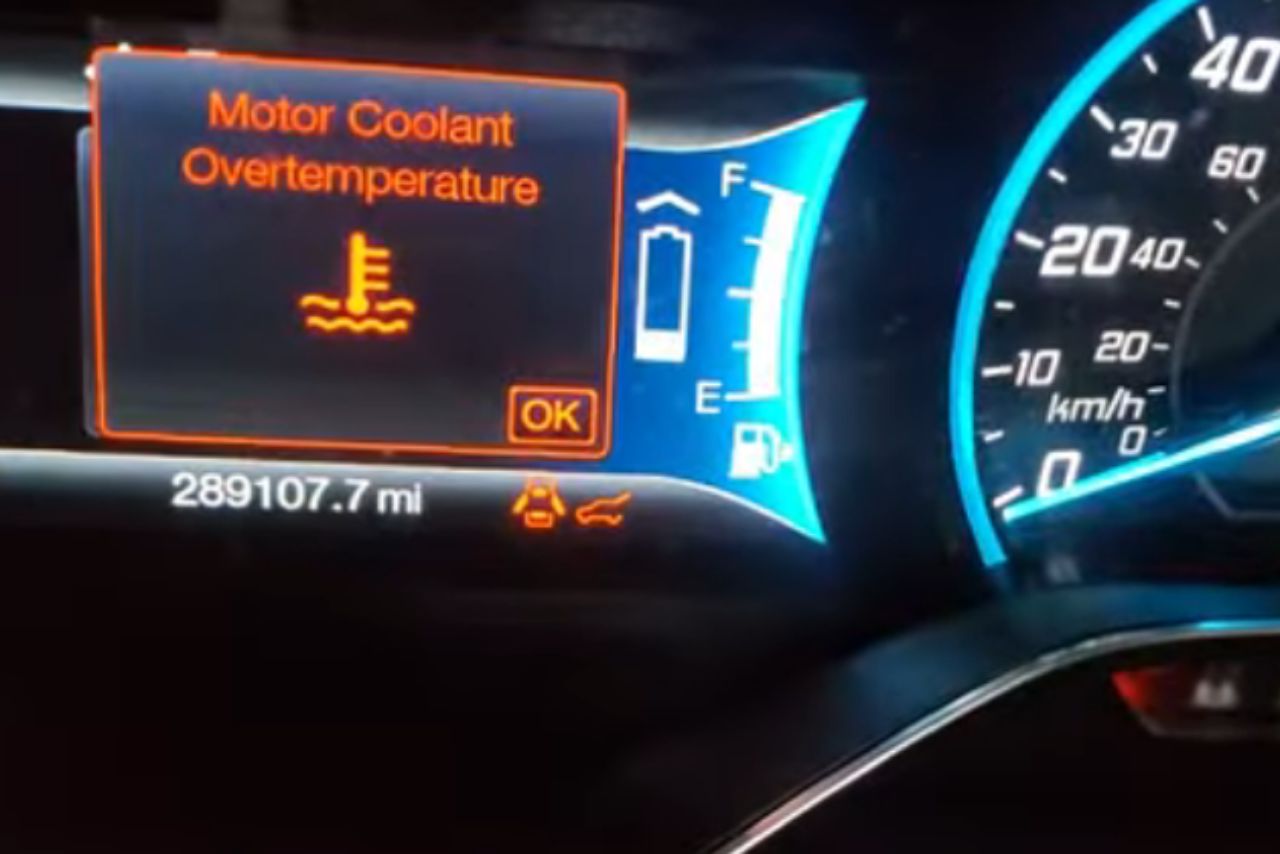The Ford Fusion is a beloved vehicle for many, but the issue of “engine coolant over temperature” can crop up and cause concern.
This problem signifies that your car’s engine is overheating due to insufficient cooling, which could lead to severe engine damage if not addressed promptly.
If your Ford Fusion’s engine coolant overtemperature light is solid, and the car won’t drive, it could indicate issues like low coolant, a faulty Mass Air Flow sensor, or problems with the radiator, thermostat, or water pump. Check coolant levels, inspect the Mass Air Flow sensor, and consider a thorough cooling system examination by a qualified Ford mechanic for a precise diagnosis and solution.
The engine coolant overtemperature light came on, and the car won’t drive. The light appeared solid after pulling out of the driveway.
Related Symptoms and Queries:
Possible Causes and Solutions Of Engine Coolant Over Temperature Ford:
Symptoms of Engine Coolant Over Temperature in Ford Fusion:
Your Ford Fusion may display certain signs when the engine coolant is overheating. Watch out for these symptoms:
The following table summarizes some common issues related to the above symptoms:
| Symptom | Possible Cause |
|---|---|
| Erratic temperature gauge | Faulty thermostat |
| Warning light on dashboard | Low coolant level or faulty sensor |
| Steam from under the hood | Coolant leak |
Here In the below image You Can see the proof 👇, one of our reader who fixed his Engine Coolant Over Temperature Ford problem by using our method this issue was due to overheating and he replaced his wiring and the issue got fixed! 😍

Table of Contents
Causes of Engine Coolant Over Temperature in Ford Fusion:

Engine coolant over temperature is a common issue seen in Ford Fusions. Here are some key causes:
A quick glance at these issues may help identify potential problems early on:
| Issue | Signs |
|---|---|
| Faulty Thermostat | Engine heats up very quickly or fails to reach operating temperature. |
| Leaky Radiator Hoses | Pools of bright green fluid under the car. |
| Blocked Radiator | Car heats up when idle but cools when moving. |
| Low Coolant LevelsVisible drop in overflow tank, warning light on dashboard. |
Remember that regular maintenance can prevent most issues with engine temperature! Always check for signs and get them fixed before they become serious problems!
1. Checking the Coolant Level in a Ford Fusion:

It’s essential to keep an eye on your Ford Fusion’s coolant level. Here are simple steps to check it:

- If fluid level is within these marks – you’re good!
- If below MIN, add more (refer section ‘Adding Coolant’)
Adding Coolant:

Follow these steps if you need to add more liquid.
- Buy proper coolant: For Ford Fusion, use Motorcraft Orange Antifreeze/Coolant Prediluted (check user manual).
- Open radiator cap slowly & carefully.
- Pour in enough liquid so that it reaches between MIN/MAX lines of reservoir.
Table 1: Troubleshooting Engine Overheating:
| Symptom | Possible Cause |
|---|---|
| Cooling system leaking | Check hoses & joints for leakage |
| Radiator fan not working | Inspect electrical connection or fan motor |
| Thermostat malfunction | Replace thermostat |
Note: Regularly inspecting cooling system components helps prevent overheating issues!
You can also watch this video:
How to Identify a Faulty Thermostat in a Ford Fusion?
When it comes to your Ford Fusion, the thermostat plays an integral role in regulating your engine’s temperature.
If it isn’t working as expected, you might encounter an ‘engine coolant over-temperature’ warning. Here are some telltale signs that indicate a faulty thermostat:
If you’ve noticed these symptoms, perform this simple test:
- Start your car and allow it to warm up.
- Touch the radiator hose cautiously (it should be warm).
- If it stays cold even after warming up the car, there’s likely an issue with your thermostat.
To further confirm if there’s a problem with your vehicle’s cooling system:
| Step | Action |
|---|---|
| 1 | Remove the radiator cap when cool and start the engine |
| 2 | As soon as the engine warms up, coolant should flow inside visibly |
| 3 | In case of no visible movement or if bubbles appear – suspect either head gasket failure or faulty thermostat |
Remember: Always ensure safety first! Don’t risk getting burnt during any tests involving hot parts of vehicles.
Steps to Replace the Radiator Cap on a Ford Fusion:
The radiator cap of your Ford Fusion plays an important role in maintaining engine coolant temperature. Follow these steps for a hassle-free replacement:
Note: The exact location may vary depending on model year.
Now that you’ve removed it, inspect for any damages such as cracked seals or rusted metal parts.
| Signs | Indication |
|---|---|
| Cracked Seal | Possible leak |
| Rusted Metal Parts | Time for Replacement |
If you notice either sign, then proceed to replace:
- Clean up First: Wipe down any residue from the old cap and surrounding area.
- Align New Cap Properly: Ensure new cap lines up correctly before applying pressure.
- Screw On Tightly But Not Forcefully : Screw clockwise until securely sealed but not overly tight.
That’s all! You’ve successfully replaced your Ford Fusion’s radiator cap! This simple maintenance tip can help prevent “engine coolant over temperature” issues in your vehicle by ensuring optimal system pressurization—crucial for heat dispersion throughout the cooling system!
Common Issues with the Cooling System in Ford Fusions:

Ford Fusion models are often praised for their reliability, but like any vehicle, they’re not without their issues. One area that can cause problems is the cooling system.
Here’s a simple table that presents these common issues:
| Issue | Symptoms |
|---|---|
| Faulty Thermostat | Overheating, poor fuel economy |
| Blocked Radiator | High engine temperature readings |
| Leaking Coolant | Visible leakage under car |
If experiencing any of these signs:
- Check coolant levels: Low levels may indicate a leak or other problem.
- Inspect hoses and connections: Look out for visible leaks or damaged parts.
- Seek professional help: If you’re unable to identify or fix the issue yourself, take your car into a certified mechanic.
Keeping on top of maintenance will ensure your Ford Fusion’s cooling system stays effective and helps avoid major problems down the road.
The Importance of Regularly Flushing and Changing Coolant in a Ford Fusion:
Maintaining your Ford Fusion at its peak performance means being proactive about routine maintenance. One such task includes regularly flushing and changing the coolant. Here’s why it’s so important:
Schedule for Coolant Change:
Following an appropriate schedule is crucial to ensure maximum efficiency. As a general rule:
- Initial change: 100,000 miles or 5 years (whichever comes first)
- Subsequent changes: Every 50,000 miles or 3 years thereafter
| Mileage | Years from Last Change | Action Required |
|---|---|---|
| <100k | <5 | No action required |
| ≥100k | ≥5 | Initial change required |
| – | – | – |
| – | – | – |
| (Repeat every 50k/3yrs) |
Remember – these are guidelines! Always consult with a professional mechanic or refer to your vehicle’s manual for exact details.
Note: Using the right type of coolant is equally significant as following the proper schedule! For most Ford Fusions, use either Motorcraft Orange Antifreeze/Coolant Prediluted or an equivalent meeting WSS-M97B44-D specs.
Signs that Your Fan Clutch Needs Replacement on a Ford Fusion:
If your Ford Fusion’s engine coolant is over temperature, the fan clutch may need replacement. Here are some signs to look out for:
In addition, there are physical checks you can perform:
- Visual Inspection: Check if there’s any fluid leakage from the assembly.
- Spin Test: With the engine off and cool, manually spin the radiator fan. It shouldn’t rotate more than 1 full revolution if working properly.
- Resistance Test: There should be resistance while spinning when warm; no resistance implies failure of thermal component inside.
Below table summarizes these points:
| Sign | Description |
|---|---|
| Excessive heat | Regular overheating issues |
| Noisy operation | Loud noises during operation |
| Poor performance | Decreased vehicle efficiency |
| Visual inspection | Fluid leakage from assembly |
| Spin test | More than 1 rotation when spun manually (engine off) |
| Resistance test | No resistance while spinning when warm |
Remember: Always get professional help in case of serious concerns related to your vehicle’s performance!
Tips for Preventing Engine Coolant Over Temperature in Your Ford Fusion:
To keep your Ford Fusion running smoothly, it’s crucial to prevent engine coolant over temperature. Here are some key tips:
Proper Maintenance Schedule
| Mileage | Service Needed |
|---|---|
| 10,000 | Change oil and inspect radiator |
| 20,000 | Inspect hoses and belts |
| 30,000 | Flush cooling system |
Remember: Prevention is better than cure! By following these steps not only will you extend the life of your Ford Fusion but also save yourself from costly repairs down the line.
Troubleshooting Steps for Resolving Engine Coolant Over-Temperature Issues:
If your Ford Fusion is displaying an “Engine Coolant Over Temperature” warning, it’s crucial to address the issue promptly. Here are some steps you can take:
Check the coolant level:
Ensure that there is enough coolant in the reservoir.
- If low, fill up with a 50/50 mix of water and antifreeze.
Inspect for leaks:
Look around the radiator, hoses, and under your car for any signs of leaking coolant.
Test thermostat operation:
Examine Radiator Fans:
- These should kick on when engine temperature rises; if not working properly they may need replacement.
Assess Water Pump Functionality
- Listen for noises from pump or check for leaks; these could indicate issues requiring repair or replacement.
Remember to always let your engine cool before attempting any checks or fixes!
| Potential Issue | Solution |
|---|---|
| Low coolant levels | Refill with 50/50 water-antifreeze mix |
| Leaks | Repair/replace damaged parts |
| Faulty Thermostat | Replace thermostat |
| Radiator fan malfunctioning | Radiator fans may need replacing |
| Water pump problems | Repair or replace water pump |
Stay safe and remember that while DIY solutions can be helpful and cost-effective, certain issues might require professional attention!
Conclusion and final thoughts
In summary, dealing with an “engine coolant over temperature” issue in your Ford Fusion isn’t a task that should cause panic. It’s all about understanding the potential causes, and then taking appropriate measures to rectify them.
Be it faulty sensors, malfunctioning thermostats, or compromised radiators – knowing what to look for is half the battle won.
Remember that timely action can save you from expensive repairs down the line. So don’t ignore those dashboard warnings! Regular maintenance checks are also key to keeping your engine running smoothly.
Now armed with this knowledge, you’re well-equipped to handle any engine coolant temperature issues like a pro!











Leave a Reply